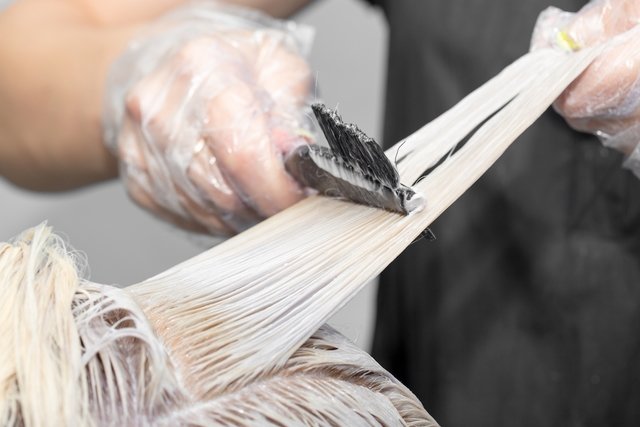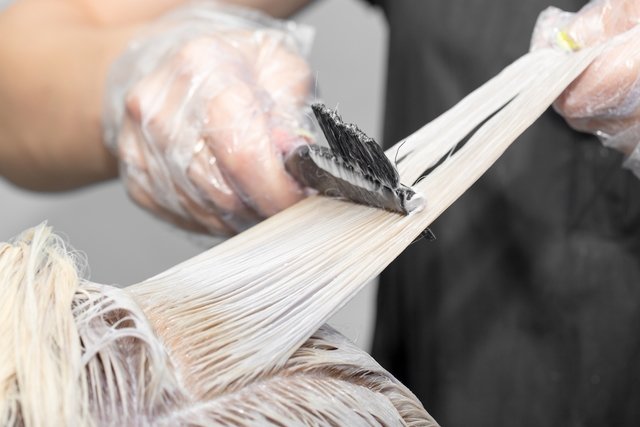Formaldehyde is a chemical substance with a strong smell that can cause allergies, irritation and intoxication when a person comes into contact with or inhales concentrations above those recommended by ANVISA.
This substance is widely used in cosmetic products, mainly in hair straightening products and nail polish, however in 2009 ANVISA determined that formaldehyde could only be used in small concentrations in cosmetic products due to possible health risks.
This indication was due to the fact that several consequences of its use had been reported, such as hair loss, scalp burns, eye irritation and intoxication. Furthermore, formaldehyde and its derivatives can induce mutations in the genetic material, DNA, increasing the risk of developing tumor cells and leading to mouth, nose and blood cancer, for example.

What is formaldehyde used for?
Formaldehyde is widely used in the creation of cosmetic products to straighten hair, as well as nail polish. Since 2009, ANVISA has determined a maximum concentration for this purpose.
Furthermore, formaldehyde is also used in laboratories to preserve animal species or anatomical parts, and this use is authorized by ANVISA, as long as people are properly protected by using protective glasses, masks, gloves and a gown.
Health risks of formaldehyde
The frequent use of formaldehyde or the contact and inhalation of large quantities poses a health risk due to the fact that formaldehyde is capable of causing genetic changes and, thus, interfering with several processes of normal cellular metabolism, in addition to being capable of reducing the function of some organs.
Contact or inhalation of formaldehyde can be related to several health complications, especially with regard to the development of cancer. Furthermore, depending on the contact with formaldehyde, there may be other health risks:
- Changes in the respiratory tract, such as bronchitis, pneumonia or laryngitis;
- Changes in the skin, which may result in dermatitis, formation of ulcers and local necrosis;
- Hair loss and scalp burns;
- Poisoning, which can result in death if the concentration of formaldehyde with which there was contact was very high.
The risks of using formaldehyde are even greater in the case of children, as the genetic changes caused by formaldehyde can occur more easily and, therefore, children are at greater risk of developing cancer.
It is important to keep in mind that formaldehyde in the concentration authorized by ANVISA does not have a straightening function. Therefore, if during the hair straightening procedure a very strong smell characteristic of formaldehyde is smelled, for example, it is important to notify ANVISA or Health Surveillance so that an inspection can be carried out at the establishment, as the product may be adulterated.
Does using formaldehyde cause cancer?
Prolonged and continuous use or exposure to formaldehyde can lead to cancer, as its effects are cumulative. This happens because formaldehyde, its derivatives or substances that can release it, such as glyoxylic acid, for example, can have a mutagenic effect, that is, they can induce mutations in DNA and lead to the production and proliferation of malignant cells, resulting in cancer. nose, mouth, larynx and blood, mainly.
Due to its carcinogenic potential, the indiscriminate use of formaldehyde in cosmetic products was banned by ANVISA in 2009. Therefore, ANVISA is only authorized for formaldehyde to be used as a nail hardening agent in a concentration of up to 5% and as a preservative agent in a concentration of up to 0.2%, with the handling of formaldehyde in beauty salons and the addition of formaldehyde in products registered by ANVISA being prohibited, as these already have the recommended formaldehyde concentration.
Signs of formaldehyde poisoning
Frequent exposure or high concentrations of formaldehyde can cause irritation and lead to signs and symptoms of intoxication, the main ones being:
- Skin irritation, which can be noticed through redness, pain, burning and peeling;
- Eye irritation, with excessive tearing, conjunctivitis and blurred vision;
- Irritation of the respiratory tract, which can result in pulmonary edema, irritation in the nose;
- Decrease in respiratory rate;
- Headache;
- Loss of hair;
- Nausea;
- Diarrhea;
- Cough;
- Enlargement of the liver, in case of prolonged contact.
In the case of beauty salons, professionals and clients who perform formaldehyde-based straightening treatments are often more likely to have reactions associated with exposure to the substance, as well as a greater chance of developing cancer. Therefore, it is important to avoid the use of formaldehyde and look for alternatives for these procedures. See how to straighten your hair.
Bibliography
- INCA. Frequently Asked Questions: Formaldehyde. Available at: <https://www.inca.gov.br/perguntas-frequentes/formol>. Accessed on April 2, 2020
- FASTH, Ida M.; ULRICH, Nina H.; JOHANSEN, Jeanne D. Ten-year trends in contact allergy to formaldehydeand formaldehyde-releasers. Contact Dermatitis. Vol 79. 263-269, 2018
- ALLEGRA, Alessandro et al. Formaldehyde Exposure and Acute Myeloid Leukemia: A Review of the Literature. Medicine. 2019
- BRAZILIAN SOCIETY OF DERMATOLOGY. Risks of formaldehyde – Dermatologists warn against the use of the substance in hair procedures. 2019. Available at: <https://www.sbd.org.br/mm/cms/2019/12/27/guiacuidadosformol-2.pdf>. Accessed on April 2, 2020
- DIAS, Tânia Cristina S. In vitro evaluation of the effect of different chemical/thermal straightening processes on hair fiber. Doctoral thesis, 2015. University of São Paulo.

Sign up for our newsletter and stay up to date with exclusive news
that can transform your routine!
Warning: Undefined array key "title" in /home/storelat/public_html/wp-content/plugins/link-whisper-premium/templates/frontend/related-posts.php on line 12
Warning: Undefined array key "title_tag" in /home/storelat/public_html/wp-content/plugins/link-whisper-premium/templates/frontend/related-posts.php on line 13




